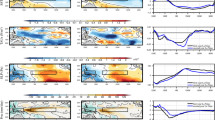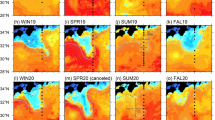Abstract
Arctic sea ice extent has been declining in recent decades. There is ongoing debate on the contribution of natural internal variability to recent and future Arctic sea ice changes. In this study, we contrast the trends in the forced and unforced simulations of carefully selected global climate models with the extended observed Arctic sea ice records. The results suggest that the natural variability explains no more than 42.3% of the observed September sea ice extent trend during 35 a (1979–2013) satellite observations, which is comparable to the results of the observed sea ice record extended back to 1953 (61 a, less than 48.5% natural variability). This reinforces the evidence that anthropogenic forcing plays a substantial role in the observed decline of September Arctic sea ice in recent decades. The magnitude of both positive and negative trends induced by the natural variability in the unforced simulations is slightly enlarged in the context of increasing greenhouse gases in the 21st century. However, the ratio between the realizations of positive and negative trends change has remained steady, which enforces the standpoint that external forcing will remain the principal determiner of the decreasing Arctic sea ice extent trend in the future.
Similar content being viewed by others
References
Comiso J C, Nishio F. 2008. Trends in the sea ice cover using enhanced and compatible AMSR-E, SSM/I, and SMMR data. Journal of Geophysical Research: Oceans (1978–2012), 113(C2): doi: 10.1029/2007JC004257
Day J J, Hargreaves J C, Annan J D, et al. 2012. Sources of multidecadal variability in Arctic sea ice extent. Environmental Research Letters, 7(3): 034011
Ellis B, Brigham L. 2009. Arctic marine shipping assessment 2009 report. Ottawa: Arctic Council
Enfield D B, Mestas-Nuñez A M, Trimble P J. 2001. The Atlantic multidecadal oscillation and its relation to rainfall and river flows in the continental U.S. Geophysical Research Letters, 28(10): 2077–2080
Fetterer F, Knowles K, Meier W, et al. 2009. Sea ice index [1979–2000]. Boulder, Colorado USA: National Snow and Ice Data Center, http://nsidc.org/data/G02135
Francis J A, Vavrus S J. 2012. Evidence linking Arctic amplification to extreme weather in mid-latitudes. Geophysical Research Letters, 39(6): doi: 10.1029/2012GL051000
Kay J E, Holland M M, Jahn A. 2011. Inter-annual to multi-decadal Arctic sea ice extent trends in a warming world. Geophysical Research Letters, 38(15): doi: 10.1029/2011GL048008
Kinnard C, Zdanowicz C M, Fisher D A, et al. 2011. Reconstructed changes in Arctic sea ice over the past 1450 years. Nature, 479(7374): 509–512
Liu Jiping, Curry J A, Wang Huijun, et al. 2012. Impact of declining Arctic sea ice on winter snowfall. Proceedings of the National Academy of Sciences of the United States of America, 109(11): 4074–4079
Liu Jiping, Song Mirong, Horton R M, et al. 2013. Reducing spread in climate model projections of a September ice-free Arctic. Proceedings of the National Academy of Sciences of the United States of America, 110(31): 12571–12576
Massonnet F, Fichefet T, Goosse H, et al. 2012. Constraining projections of summer Arctic sea ice. The Cryosphere, 6(6): 1383–1394
Meier W N, Stroeve J, Barrett A, et al. 2012. A simple approach to providing a more consistent Arctic sea ice extent time series from the 1950s to present. The Cryosphere, 6(6): 1359–1368
Miles M W, Divine D V, Furevik T, et al. 2014. A signal of persistent Atlantic multidecadal variability in Arctic sea ice. Geophysical Research Letters, 41(2): 463–469
Moss R H, Edmonds J A, Hibbard K A, et al. 2010. The next generation of scenarios for climate change research and assessment. Nature, 463(7282): 747–756
Notz D, Marotzke J. 2012. Observations reveal external driver for Arctic sea-ice retreat. Geophysical Research Letters, 39(8): doi: 10.1029/2012GL051094
Post E, Bhatt U S, Bitz C M, et al. 2013. Ecological consequences of sea-ice decline. Science, 341(6145): 519–524
Screen J A. 2013. Influence of Arctic sea ice on European summer precipitation. Environmental Research Letters, 8(4): 044015
Smith L C, Stephenson S R. 2013. New Trans-Arctic shipping routes navigable by midcentury. Proceedings of the National Academy of Sciences of the United States of America, 110(13): E1191–E1195
Stroeve J C, Kattsov V, Barrett A, et al. 2012. Trends in Arctic sea ice extent from CMIP5, CMIP3 and observations. Geophysical Research Letters, 39(16): doi: 10.1029/2012GL052676
Swart N C, Fyfe J C, Hawkins E, et al. 2015. Influence of internal variability on Arctic sea-ice trends. Nature Climate Change, 5(2): 86–89
Tang Qiuhong, Zhang Xuejun, Francis J A. 2014. Extreme summer weather in northern mid-latitudes linked to a vanishing cryosphere. Nature Climate Change, 4(1): 45–50
Taylor K E, Stouffer R J, Meehl G A. 2012. An Overview of Cmip5 and the Experiment Design. Bulletin of the American Meteorological Society, 93(4): 485–498
Thompson D W J, Wallace J M, Hegerl G C. 2000. Annular modes in the extratropical circulation. Part II: Trends. Journal of Climate, 13(5): 1018–1036
Vinnikov K Y, Robock A, Stouffer R J, et al. 1999. Global warming and Northern Hemisphere sea ice extent. Science, 286(5446): 1934–1937
Wang Muyin, Overland J E. 2012. A sea ice free summer Arctic within 30 years: An update from CMIP5 models. Geophysical Research Letters, 39(18): doi: 10.1029/2012GL052868
Author information
Authors and Affiliations
Corresponding author
Additional information
Foundation item: The National Natural Science Foundation of China under contract Nos 41305097 and 41176169.
Rights and permissions
About this article
Cite this article
Song, M., Wei, L. & Wang, Z. Quantifying the contribution of natural variability to September Arctic sea ice decline. Acta Oceanol. Sin. 35, 49–53 (2016). https://doi.org/10.1007/s13131-016-0854-5
Received:
Accepted:
Published:
Issue Date:
DOI: https://doi.org/10.1007/s13131-016-0854-5




